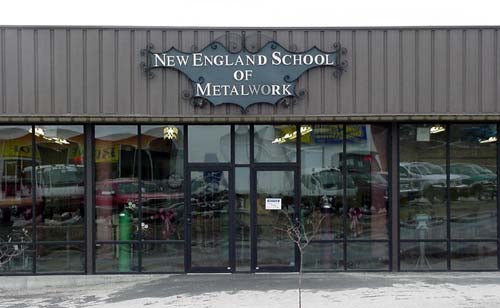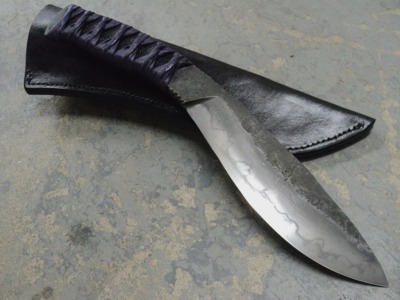Watching a Blacksmith at Work on a Steel Forging Field Trip
Tony Sculimbrene 04.28.15

If you have never seen a blacksmith make something live, you really should. Theirs is a primal craft of beating metal into shapes using fire and hammers. Even amateurs make it look awesome. With each hammer blow, the blacksmith sends a shower of sparks flying. Out a bar of steel the size of two candy bars, they create something lasting and authentic. And that’s what happens when newbs step up to the anvil. When you get to see a true master, someone like Nick Rossi, do his thing, it’s an entirely different experience, something akin to a complex physical routine like a gymnast’s performance at the Olympics, only with a superheated oven and giant hammers.
Last June, my son and I ventured up to Central Maine, and thanks to a hook-up from a friend, we were able to see Nick Rossi forge some knives at New England School of Metalwork, at the time the only ABS certified school in the US.
It was a Saturday and things were very quiet because, well, this is Lewiston, Maine and things are always pretty quiet. We pulled up to the small building and out came a person that looked like a blacksmith from central casting in Hollywood–tall, bearded, with massive arms and a blacksmith’s apron (including requisite burn marks). He introduced himself as Nick Rossi and invited us in to the workshop for a look around.
The building itself was very clean, especially for a workshop.

There were grinders on stands, work benches, and one furnace. Just in front of the furnace was a massive anvil on a stand. Leading from each grinder and the furnace was an array of pipes and tubes, undoubtedly to vent gas and collect metal shavings. Even from across the room the furnace was hot enough to make your skin tingle. The shop alone transfixed both my son and I.
Then Nick asked us if we wanted to watch him forge some blades. Given his reputation, we said yes. After all, you wouldn’t say no to Mike Trout if he said he wanted to show you the secrets of his swing. Nick grabbed a piece of metal and began working. Using giant tongs he slid the bar stock into the furnace and got it cherry red. Once it reached the right color, he pulled it out and started working the steel. He used the entirety of the anvil–the flat main surface, the edges and corners, and the horn (the pointy part in the front). Each time the bar stock was expertly manipulated into various shapes. Nick was so smooth with his hammering that he could feed the steel into the hammer and make a circle in seconds. This circle would form the end of a handle on the knife he was making, and it was perfectly round.
After that Nick tossed the metal back in to the furnace, pulled it out, and began shaping the blade. It was a careful process, heat, pound, pull, shape, then repeat. Over time the thick bar stock thinned significantly and it became more knife shaped and less Hershey bar shaped. Both my son and I watched with rapt attention. There were more than a few times that I saw Nick do something and think–yikes he made a mistake. But each time I was wrong. Each time the technique that he used was exactly the right thing and there were quite a few times where I had that Bob-Ross-painting-a-mountain moment of revelation. In those moments I realized just how damn good Nick was. I had seen other blacksmiths work before, quite a few times actually, but none show the quickness and skill Nick did.
After finishing the knife, a fixed blade, Nick came over and talked. He explained that the knife was a garden knife and it would be sold at an upcoming fair. His reputation has made him something of a minor celebrity in the garden and snooty cooking circles of Maine–a Nick Rossi blade was, apparently, the only way to go for those folks. And it was easy to see why. Nick showed me a finished garden blade, made out of a special formulation of 1084, and I was blown away by the edge and the refinement of the handle and blade. Apparently Nick’s not just a great blacksmith, he is also a sharpening savant. In a case of small world syndrome, a few months later I ran into Nick’s old boss at a knife store and he confirmed what that garden knife told me–Nick can put an edge on a blade like no one else.
After the little forging demo, Nick gave my son and I a tour of the school. The building we were in was only one of two buildings. The other was under construction–rehabbing an old gas station into a blacksmith workshop. In the middle of the new building was a positively massive power hammer, so big that it had to be mounted on its own foundation–something like eight feet of solid concrete laid beneath the metal mashing behemoth.

Nick told us that the hammer was so strong that once it was going, it could shake apart weld beads that were still molten, even if they were across the building.
After the tour of the new building, Nick showed me what I most wanted to see (aside from him mashing steel): his blades. He was carrying a higonokami design that he made and it had, as expected, a straight razor’s edge. In another building he showed off some of his fixed blades, including a kukhri knife that he had won a cutting competition with recently.

Each blade was as sharp as I could imagine and each exhibited the skills of a master–clean even grinds, meticulous cutting edges, and crisp plunge lines. Any one of these knives would be the highlight of my collection.
As my son and I left, Nick and I chatted steels. He told me that he really enjoyed using the special formulation of 1084 that he was forging. He also told me that when he gets around to making his first custom folder that it might have W2 in it, a rare high carbon steel that holds a great edge and also produces hamons so smokey they’d look right at home at a cigar bar.
Overall the experience was a great one. Nick was a super nice guy, and he even had small safety glasses for my son. Naturally I told him I’d take one of his folders whenever he gets around to making it, but even if that never happens, the trip was easily worth it. Blacksmithing is a craft anyone can appreciate, and if you happen to like knives and steel, all the better. For a local hammer in (knife forging demo) click here.